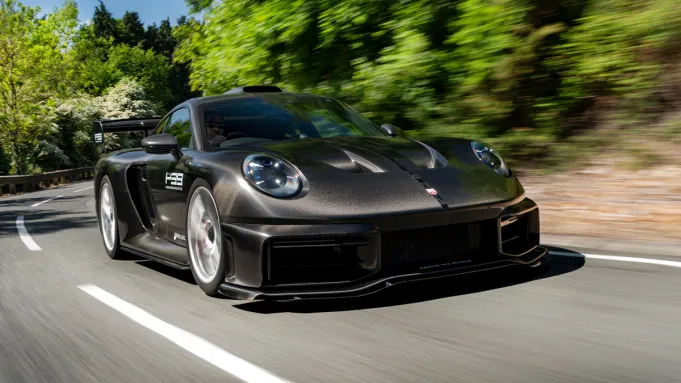
It’s hard to imagine stepping out of a 2025 Porsche 911 Turbo S and asking for almost 300 more horses, which means that the new RML GT Hypercar (GTH) may answer a question that nobody asked. But drive this extreme, reimagined 911 and somehow it makes sense. The RML Group has been building race cars and tackling white-label engineering projects since 1984, when the British automotive house originally made waves across the Atlantic by developing the Saleen S7—arguably America’s first hypercar.
More recently, RML launched a vehicle under its own banner: the Ferrari-inspired Short Wheelbase, which combined the styling of a 250 GT SWB with the V-12 heart of a 550 Maranello—a car we drove in 2022. Fittingly, beyond having “Hypercar” in its name, this new arrival belongs in that category by its very nature.

Putting a prototype of the RML GT Hypercar through its paces.
Max Earey, courtesy of RML
Design
RML’s GTH is a very different prospect to its Ferrari-inspired Short Wheelbase model. Each GTH starts life as a Porsche 911 Turbo S (the outgoing 992.1 model), then is re-bodied in carbon fiber and given bespoke suspension and radical active aero—including a driver-activated drag reduction system (DRS). The 3.7-liter six-cylinder engine gains a roof-mounted intake, Inconel exhaust, improved cooling, and a torrent of additional twin-turbo boost. Its 920 hp output surpasses that of even Stuttgart’s homegrown hypercar: the 918 Spyder.
The GTH’s mission is to offer the everyday usability of a 911 Turbo with track performance that exceeds the current GT3 RS. With the GTH, RML is targeting a Nürburgring lap time of 6 minutes 45 seconds, around four seconds quicker than Porsche’s winged wonder, and an attempt is planned for spring of 2026. A total of 39 examples will be built, and production is now underway, with GTH No. 01 recently unveiled at the Salon Privé concours. Prices start at approximately $665,000, excluding taxes and a donor car.

Each of RML’s GT Hypercars starts life as a Porsche 911 Turbo S, then is re-bodied in carbon fiber and given bespoke suspension and radical active aero.
Max Earey, courtesy of RML
The vehicle I’m driving is RML’s “P39” prototype, which has racked up thousands of demanding test miles, many in the hands of British Touring Car Championship ace Tom Chilton. Its naked carbon-fiber body bears the scuffs and scars of life as a development hack, but its steroidal wheelarches, extendable rear spoiler, and brutal diffuser deliver an emphatic statement of intent. No question, this mutant Porsche means business.
Before I get behind the wheel, RML CEO Paul Dickinson—previously CFO at Lotus and a key player in the relaunch of Bentley’s Mulliner coachbuilding division—shows me around the company’s facility. One area is dedicated to hybrid battery production for the Czinger 21C (claimed to be “the most power-dense batteries for automotive use in the world”). Another is focused on building restomods for a British client we can’t mention here. And another is dedicated to restoring classic, single-seat racing cars. “We try to be engineering agnostic,” explains Dickinson.

The cabin is similar to that of the latest 911 Turbo S, save for the new steering wheel (taken from the GT3 RS), a digital rearview mirror, and a roll cage.
Max Earey, courtesy of RML
Fresh from its show debut, GT Hypercar No. 01 is also receiving some TLC in the workshop. It looks fantastically exotic in Storm Purple (an Aston Martin color) with a tinted visible-carbon finish that’s offset by gold center-lock wheels and hand-painted gold badges. All of the subsequent 38 cars will be unique. Much as is the case with Bentley Mulliner, the only limits in terms of custom content are your imagination and your bank balance.
Power Train and Hardware
Dickinson then leads me outside to where the P39 awaits. Its water-cooled engine is idling impatiently, a resonant snarl spewing forth from its twin tailpipes. This is no silky Maranello V-12; the noise is raw and uncouth. I take a deep breath, promise to be careful with this irreplaceable, one-off prototype, and drop down into the hard-shell carbon seat.
At first glance, the RML GTH seems cut from the same cloth as the Kalmar 9×9 we drove last winter. However, while both employ the water-cooled flat-six engine, a dual-clutch auto transmission, and electronic hardware from a 992 Turbo S to deliver in excess of 900 hp, the Kalmar is based around the structure of a 993-generation 911, circa the 1990s.

The car is fit with a 920 hp, 3.7-liter six-cylinder engine mated to a dual-clutch auto transmission.
RML
The GTH’s cabin will be familiar to anyone who has just stepped from the latest 911 Turbo S. The main differences are a new steering wheel (taken from the GT3 RS), a digital rearview mirror (needed due to the lack of a rear screen), and a roll cage where previously there were back seats. Porsche’s quality plastics, a 10.9-inch central touchscreen, integration of a Bose audio system, and wireless smartphone connectivity are still present and correct. It might look intimidating on the outside, but the RML makes you feel comparatively at ease once inside.
Performance
It’s an impression bolstered during your first few miles. The paddle-shift PDK transmission is seamless in automatic mode, and ride comfort is comparable to that of a Turbo S. In fact, the new top mounts and custom R53 Engineering dampers are said to offer three percent more compliance than the donor 911. And a four-corner hydraulic-lift system takes the worry out of speed humps or heavily rutted roads.
Like a GT3 RS, there are four dials on the steering wheel to adjust drive mode, suspension stiffness, differential lock, and stability/traction control. In maximum-attack Track mode, the GTH’s front splitter slides forward by three inches, while a section of the rear spoiler pivots to a more aggressive angle. Configured thus, maximum downforce is 2,035 pounds at 177 mph. By comparison, a factory-spec RS delivers 1,896 pounds of downforce at the same speed.

RML claims the GT Hypercar covers zero to 60 mph in 2.4 seconds and tops out at 205 mph.
Max Earey, courtesy of RML
Selecting Wet mode limits output to 592 hp, while Normal turns the wick up to 740 hp. Inevitably, though, it isn’t long before I switch to Sport, find a suitably long straight, and unleash all 907 horses. Whoah! You know all those clichéd tales about the original “widow-maker” 911 Turbo, and how it abruptly hurled you at the horizon? This is the same, but played on fast-forward.
The sensation is not unlike driving McLaren hypercars, such as the Senna: a head-spinning blast of boost akin to igniting a jet afterburner. Even in this age of absurdly accelerative EVs, it still feels wild. The official numbers are zero to 60 mph in 2.4 seconds and a 205 mph maximum.

RML’s decades of engineering expertise are evident in the GT Hypercar’s technology, aerodynamics, and build quality.
Max Earey, courtesy of RML
My drive was solely on public roads, so exploring the RML’s limits—or more likely, my own as a driver—was not on the agenda. Clearly, a car this fast and capable needs a racetrack to get near its full potential. Nonetheless, the way the GTH dispatches a British back road is up there with the very best cars developed in Weissach. Its steering is nuanced and its brakes bite as hard as you’d hope. Anti-roll hydraulics and a lower stance mean body control is iron-fisted, yet still supple enough to shrug off mid-corner bumps. And the combination of four-wheel drive and Michelin Cup 2 R tires delivers so much traction (on dry asphalt, at least) that the car seems to be wearing running spikes.
Is it Worth it?
RML’s decades of engineering expertise are evident in the GT Hypercar’s technology, aerodynamics, and build quality, but they shine through most in how it drives. It’s a car that is easy to enjoy, even at sensible speeds. You could arrive at a track day, top the lap-time leaderboard, then cruise back home in comfort. Far removed from the more familiar 964-based Porsche restomods offered by the likes of Singer Vehicle Design and Theon Design, the GTH has a hardcore character of its own. For my money, it’s also a cooler choice than the latest wedge-shaped, seven-figure hypercars from Italy or Scandinavia.

This example of the finished product was recently unveiled at the Salon Privé concours.
RML
A perfect blend of 911 Turbo S and GT3 RS, then? Well, the tuned engine is very loud, which might deter you from longer journeys, and the carbon-fiber body’s additional width demands some caution on European roads—although it would be less of an issue stateside. You might also prefer the naturally aspirated scream of a GT3 RS to the forced induction whoosh of this flat-six.
Frankly, Porsche enthusiasts are spoiled for choice, but with the German automaker’s Mission X electric hypercar now seemingly cancelled, this is an exciting alternative—one that feels truer to the marque’s heritage. Never mind the question, RML’s GT Hypercar feels like the right answer.
Specifications
Vehicle Type
In Production Since
Power train
- 3.7-liter twin-turbo six-cylinder, 920 hp, 738 ft lbs of torque
- Eight-speed dual-clutch auto transmission
Performance
- Zero to 60 mph: 2.4 seconds
- Top speed: 205 mph
Price as Tested
- We tested a prototype, but customer cars start at $665,000 (excluding a donor car and taxes)
Click here for more photos of the RML GT Hypercar.
instagram:
Error: No feed with the ID 1 found.
Please go to the Instagram Feed settings page to create a feed.










